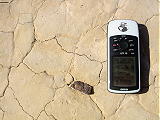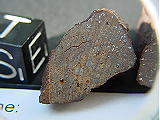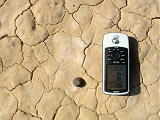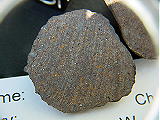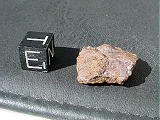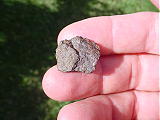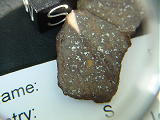![]()
Tungsten Mountain 533 (TM 533), TM 535, TM 542, TM 543 - Image Gallery
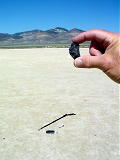
The subject of this month's "Bob's Findings" article is about four meteorite fragments found at Edwards Creek Valley, Nevada, officially named the Tungsten Mountain 533 (TM 533), TM 535, TM 542, TM 543 - Ordinary Chondrites, four stony meteorites that were found May 9th & 10th, 2007 during a "meteorite-recovery field trip" organized by this author.
These "official names" (actually, the numbers) were just recently approved by the Nomenclature Committee of the Meteoritical Society, so they are recent additions to the Meteoritical Bulletin Database, but they will eventually appear "in print" when the next Meteoritical Bulletin is published. The benefit of having the Database on-line is that images of these meteorites can be uploaded via the Encyclopedia of Meteorites.
Although these small, weathered Ordinary Chondrites may not be all that interesting, it is the fact that for all of the H-chondrites that have been found at this locality, there hasn't been a proper pairings study conducted, which is noteworthy. By the time 500 and more meteorite fragments and individuals were submitted for provisional numbers, it was very apparent to all of the field workers involved with this locality, that the vast majority of these finds were all of the same lithology, an equilibrated H-chondrite, meaning that they were presumed to be from the same fall. Yet, even the first 10 classifications of meteorites from this locality were all "equilibrated chondrites", there still was no proof that any of these were paired, let alone any proof which one of these H-chondrites represented the vast majority of the 500+ recorded finds.

| Fayalite (mol%) | Plus/minus | Petrologic Grade | Shock Stage | W. Grade | TM number | |||||||
| 17.5 | 0.1 | 4 | 2 | W3 | TM 003 | |||||||
| 17.9 | 0.1 | 4 | 2 | W3 | TM 009 | |||||||
| 18.2 | 0.2 | 5 | 2 | W3 | TM 010 | |||||||
| 18.5 | 0.2 | 5 | 3 | W3 | TM 007 | |||||||
| 18.6 | 0.1 | 6 | 2 | W5 | TM 004 | |||||||
| 19.2 | 0.2 | 6 | 2 | W5 | TM 002 | |||||||
| 19.3 | 0.5 | 4 | 2 | W3 | TM 001 | |||||||
| 20.3 | 0.3 | 5 | 3 | W2 | TM 008 | |||||||
| 25 | 0.2 | 6 | 4 | W3 | TM 006 | |||||||
| 25.5 | 0.2 | 6 | 2 | W3 | TM 005 | |||||||
TM 054 H5 S3 W4 Olivine (Fa18.6±0.4, n=9), Low-Ca Pyroxene (Fs16.5±0.5Wo1.3±0.3, n=13).
TM 055 H5 S3 W4 Olivine (Fa19.0±0.8, n=15), Low-Ca Pyroxene (Fs16.5±0.7Wo1.3±0.2, n=17).
TM 056 H5 S3 W4 Olivine (Fa18.7±0.9, n=19), Low-Ca Pyroxene (Fs16.7±0.7Wo1.4±0.2, n=20).
TM 057 H5 S3 W4 Olivine (Fa18.7±0.4, n=14), Low-Ca Pyroxene (Fs16.3±0.4Wo1.3±0.2, n=13).
TM 058 H5 S3 W4 Olivine (Fa19.1±0.6, n=18), Low-Ca Pyroxene (Fs16.8±0.6Wo1.3±0.1, n=16).
TM 059 H5 S3 W4 Olivine (Fa19.0±0.7, n=20), Low-Ca Pyroxene (Fs16.9±0.9Wo1.3±0.1, n=16).
TM 060 H5 S3 W4 Olivine (Fa18.7±0.6, n=20), Low-Ca Pyroxene (Fs16.6±0.3Wo1.3±0.2, n=14).
TM 073 H5 S3 W4 Olivine (Fa19.3±0.5, n=9), Low-Ca Pyroxene (Fs16.8±0.7Wo1.2±0.2, n=20).
TM 084 H5 S3 W4 Olivine (Fa18.9±0.5, n=16), Low-Ca Pyroxene (Fs16.9±0.8Wo1.1±0.2, n=7).
TM 116 H5 S3 W4 Olivine (Fa18.8±0.5, n=13), Low-Ca Pyroxene (Fs16.6±0.6Wo1.2±0.1, n=12).
TM 121 H5 S3 W4 Olivine (Fa18.7±0.8, n=23), Low-Ca Pyroxene (Fs16.4±0.7Wo1.0±0.3, n=12).
Here is the REVISED chart of select classified TM finds - with the addition of the above "Olivine" values:

UPDATE (2015): Added 2 more H-chondrite classifications, and number approvals (TM 572 & TM 573) . It is common consensus that TM 572 is paired to TM002.
Based upon my examination of dozens of cut fragments from Edwards Creek Valley, it is my observation that the vast majority of fragments are paired to TM 007 (H5).
UPDATE (2011): The addition of the 6 latest H-chondrite classifications to the above table ONLY confirms that four of the six stones classified as H5 are "probably-paired" (excludes TM 008 & TM 563), and that the H4 stones continue to be too variable to be considered paired. There is still not enough evidence to form a consensus opinion as to which classification represents the meteorite which produced all of the "similar-looking" fragments which constitutes the vast majority of the more than 600 found chondritic stones!
It is my observation that there is a tendency to only submit TM specimens for classification if they appear to "look different" from the vast majority of other finds from this locality. Consequently, the list of classifications is more a list of the "uncommon" meteorites found at Edwards Creek Valley.
Hence, there is a need for more finds to be submitted for classification.
Luckily, my 5 submissions were accepted. Not only that, but the "turn-around" time in getting a classification was surprising short.
What can be learned from this, is that even though there can be long delays and great difficulty in getting some common meteorites classified, it isn’t always the case. Hopefully, with time this problem will improve and it will be less and less used as an excuse for not getting finds submitted for classification.
I had these Tungsten Mountain finds classified at the same institution that classified most of the other finds from this locality.
Over 5 years ago I made the following statement and it holds true even more so today:
"There are more than a couple reasons why a finder would want his meteorite classified by the same person who had classified other finds from that same locality. And it's more than the fact that it is only proper protocol to give first consideration to the researcher that is conducting a study of that locality. The most obvious reason would be that pairings could be done much easier. In fact, it is becoming more apparent that meteorites, that are obviously paired, are having great difficulty in getting paired when they are getting classified by different institutions. "
Now that 18 out of the 19 classified finds from Tungsten Mountain have been done at the same institution, and their type specimens are available for proper pairings, it would be more that just proper protocol to have future Tungsten Mountain finds classified at that same institution. It would actually be the most prudent thing to do, as long as there is any interest in pairing all of these dry lake finds. I would think this would be a common interest of both collectors and researchers. Hopefully, for other multiple find localities across the Southwest US, we will see a consensus form among finders and researchers that promotes this protocol.
| Tungsten Mountain 240 | H4 | S1 | W5 | Fa = 16.9±0.1 n=8 | opx: Fs15.6Wo3.0 n=1 | 41.6 g | |
| Tungsten Mountain 533 | H5 | S3 | W2 | Fa = 18.6±0.2 n=7 | Fs = 16.4±0.2, Wo = 1.3 n=5 | 25.3 g | |
| Tungsten Mountain 535 | H4 | S1 | W5 | Fa = 18.1±0.2 n=4 | Fs = 16.2, Wo = 1.3 n=2 | 26.1 g | |
| Tungsten Mountain 542 | H5 | S3 | W1 | Fa = 18.3±0.1 n=7 | Fs = N/A | 4.6 g | |
| Tungsten Mountain 543 | H4 | S2 | W3 | Fa = 18.5±0.3 n=6 | Fs = N/A | 18.1 g | |
| Tungsten Mountain 563 | H5 | S3 | W2 | Fa = 19.0±0.7 n=5 | Fs = N/A | 9.3 g | |
| Tungsten Mountain 572 | H6 | S1 | W3 | Fa = 19.1±0.1 n=6 | Fs = N/A | 10.7 g | |
| Tungsten Mountain 573 | H4 | S2 | W3 | Fa = 18.8 n=5 | Fs = 16.5 | 68 g |
The following are links that take you to the Meteoritical Bulletin description for that Tungsten Mountain meteorite. And if you "click" on an image, you can be linked to an "Enlarged" version of that image. The images are of each meteorite "as it was found" on the playa and of the type-specimenwhile under study in my lab:
Tungsten Mountain 533 - this meteorite is now classified and officially NUMBERED:
H5, S3, W2 (Fa 18.6+/-0.2% n=7, Fs 16.4%, Wo 1.3% n=5)
Tungsten Mountain 535 - this meteorite is now classified and officially NUMBERED:
H4, S1, W5 (Fa 18.1+/-0.2% n=4, Fs 16.2%, Wo 1.3% n=2)
Tungsten Mountain 542 - this meteorite is now classified and officially NUMBERED:
H5, S3, W1 (Fa 18.3+/-0.1% n=7, Fs = N/A)
Tungsten Mountain 543 - this meteorite is now classified and officially NUMBERED:
H4, S2, W3 (Fa 18.5+/-0.3% n=6, Fs = N/A)
Tungsten Mountain 572 - this meteorite is now classified and officially NUMBERED:
H6, S1, W3 (Fa 19.1+/-0.1% n=6, Fs = N/A) -- Most-likely paired to TM 002 !!
My previous articles can be found *HERE*
For for more information, please contact me by email:
Bolide*chaser
